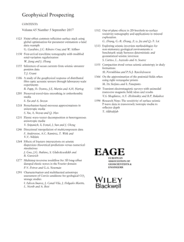
Full text loading...
A method for interpolation of multicomponent streamer data based on using the local directionality structure is presented. The derivative components are used to estimate a vector field that locally describes the direction with the least variability. Given this vector field, the interpolation can be phrased in terms of the solution of a partial differential equation that describes how energy is transported between regions of missing data. The approach can be efficiently implemented using readily available routines for computer graphics. The method is robust to noise in the measurements and particularly towards high levels of low‐frequent noise that is present in the derivative components of the multicomponent streamer data.

Article metrics loading...

Full text loading...
References


Data & Media loading...

